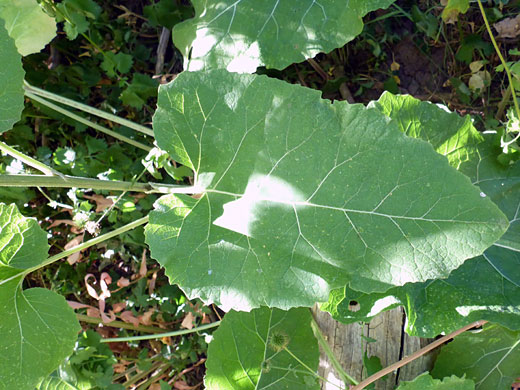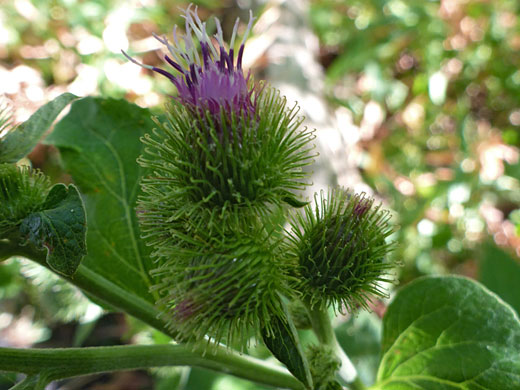
Purple florets and green phyllaries of arctium minus; Cascade Springs, Uinta-Wasatch-Cache National Forest, Utah
Common names:
Common burdock, lesser burdock
Family:
Scientific name:
Arctium minus
Main flower color:
Range:
Parts of all the western states except Texas (non native)
Height:
Up to 10 feet
Habitat:
Disturbed ground, roadsides, fields; sea level to 7,200 feet
Leaves:
Alternate, stalked, ovate, up to 30 inches long, with toothed or entire margins
Season:
July to September
Arctium minus is the most widespread of three species of this non-native genus to have become established in the US. Stems are tall, erect, and branched (mostly towards the base), bearing large leaves at alternate intervals; these can be over 2 feet long at the base, becoming gradually smaller up the stem. Leaf margins are usually irregularly and shallowly toothed. Leaves have prominent, light-colored veins. Leaf bases are heart-shaped.
The spherical, thistle-like flowerheads are produced in small clusters at the top of the stem, subtended by a few leafy bracts. Flowerheads consist of many rows of recurved, linear, hooked phyllaries, hairy or hairless, below several dozen disc florets, colored purple to pink. The disc corollas are tubular, opening to four triangular lobes from which projects an exserted, white-purple style topped by a branched stigma.
The spherical, thistle-like flowerheads are produced in small clusters at the top of the stem, subtended by a few leafy bracts. Flowerheads consist of many rows of recurved, linear, hooked phyllaries, hairy or hairless, below several dozen disc florets, colored purple to pink. The disc corollas are tubular, opening to four triangular lobes from which projects an exserted, white-purple style topped by a branched stigma.
All Contents © Copyright The American Southwest | Comments and Questions | Contribute | Site Map


